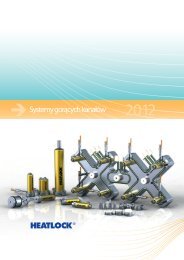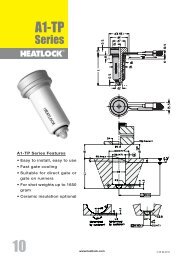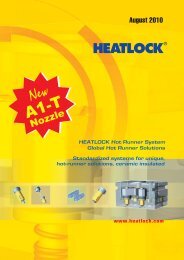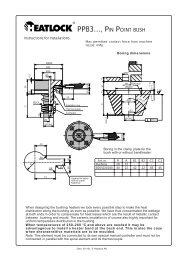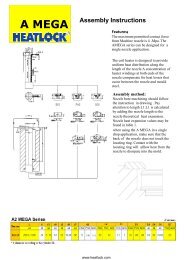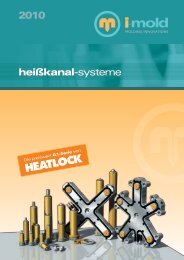Heatlock ESB2, Electric Sprue Bushing
Heatlock ESB2, Electric Sprue Bushing
Heatlock ESB2, Electric Sprue Bushing
You also want an ePaper? Increase the reach of your titles
YUMPU automatically turns print PDFs into web optimized ePapers that Google loves.
This <strong>Heatlock</strong> series, below, is currently being replaced by the A1-series of nozzles.<br />
Before you design check availability, stock is gradually decreased.<br />
Spare parts will be available until at least end of 2007 (apart form NPT1 bodies)<br />
If the bushing is installed as shown in the diagram, all cables will be protected from plastic.<br />
If possible there shall be no contact between the back end of the bushing and the guide ring<br />
of the mould. Such contact will cause a heavy drop in temperature at the back end of the<br />
bushing. If the force at which the machine nozzle is pressed against the sprue bushing is<br />
greater then that caused by the injection force on the front area of the bushing, nothing is<br />
needed to keep bushing in place axially. The bushing can then be installed as shown in the<br />
diagram below. Max permitted contact<br />
max 1.5<br />
force from machine nozzle: 4 Mp.<br />
If a support is needed to fix the bushing<br />
axially the contact area must be as small<br />
as possible. The support area should<br />
preferably be as far as possible from the<br />
centre of the bushing. (Not on the flange.)<br />
Preferably an insulation ring part No.<br />
KE05604408 shall be placed between the<br />
back support and the surface of the<br />
bushing.<br />
Colour code for thermocouple wires.<br />
Black (red) wire + (Iron) Vit (blue) wire —.<br />
The connector sleeve of the thermocouple has a max. temperature resistance of 240 ϒC.<br />
Fitting of the front end of the bushing.<br />
A certain amount of cooling is needed at front<br />
end. It must remain at a temperature low enough<br />
to make the plastic solidify. Too much cooling will<br />
however cause the plastic in the flow channel to<br />
be highly viscous further into the bushing.<br />
The contact surface at the front end may therefore<br />
have to be trimmed depending on, for example,<br />
temperature wanted and cycle time.<br />
Length of contact at front end can usually be<br />
2mm. For high temperature plastic and for long cycle time a shorter length may be needed<br />
(down to about 0,75mm). The fit at the front end in the mould also has an influence on the<br />
temperature at that area. A hard fit gives more cooling then a loose one.<br />
On injection moulding with fast-injecting materials it may sometimes be necessary to have a<br />
length of contact greater than 2 mm, so that sufficient heat can be carried away from the front<br />
face. This may mean increasing the temperature of the bushing during startup and reducing<br />
it in continuous operation.<br />
Length of the bushing.<br />
When fitting the bushing into the mould it is<br />
essential to bear in mind that its length<br />
increases when it get hot. Approx. elongation of<br />
bushing at 200 ϒC<br />
L46<br />
L66<br />
L86<br />
L116<br />
L146<br />
L176<br />
approx. 0,10 mm<br />
approx. 0,17 mm<br />
approx. 0,22 mm<br />
approx. 0,27 mm<br />
approx. 0,38 mm<br />
approx. 0,46 mm<br />
Appendix – 24<br />
Date: 050326, © <strong>Heatlock</strong> AB<br />
© LKM <strong>Heatlock</strong> Co Ltd




